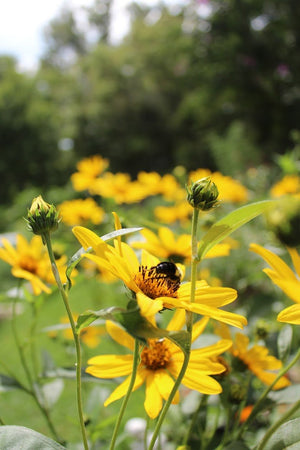Is Fall A Good Time to Plant?

As summer wanes and blooms abound, you might be wondering if it’s a good time to add to (or start!) your garden.@gardenforwildlife #GardenForWildlife #NativePlants #PollinatorGarden #SaveTheBees #GardenTips ♬ Storytelling - Adriel
Simply put, yes, fall is a great time to plant native plants, like flowers and trees and shrubs. Planting in fall allows for plants’ roots to establish quickly and ensures new growth in spring.
Why plant in the fall?
Warm soil + more rain = the key to happy planting! You may not see much growth above ground, but new roots developing now will provide a quick start for plants next spring. Next year, these fall-planted gardens will grow quickly and look similar to plants that have been around longer.
If you take pictures of your garden throughout the seasons, you may observe what’s working and where you may have opportunities to dig in. Take shots from different angles at different times of the year, and you may see things you haven’t seen before. Fall is a great time to tackle the empty spots.
Late summer and fall usually have a shorter garden chore list as you get to enjoy the fruits of your labor, so utilizing that extra time planting will pay off in spring.
Tips for fall planting
Conventional lawns and many ornamental exotic plants require an exorbitant amount of clean water to stay green. Choosing native plants that are adapted to regional rainfall and soil moisture content is a great way to conserve this precious resource. Generally, autumn has reliable rainfall, but if your area is drier or unusually hot, be sure to adequately water any new plantings.
Mulch is multi-purpose in the garden! Mulch helps plants retain soil moisture, and can improve soil quality. It can also help insulate new plants if cold weather is lurking around the corner.
Leave the leaves! Like mulch, fallen leaves can be beneficial for plants and wildlife. “Leaves form a natural mulch that helps suppress weeds and fertilizes the soil as it breaks down. Why spend money on mulch and fertilizer when you can make your own? Turning leaves into solid waste is, well, wasteful,” says National Wildlife Federation Naturalist David Mizejewski. Read more about what to do with leaves this fall.
When is it too late to plant?
The key here is avoiding the ground freezing, as it will halt any plant growth. It’s not necessarily frost. Frost will stop the growth of the plant above ground, but will not kill the plant. The roots will continue to grow until the soil freezes solid.
The date the ground actually freezes varies from year to year, of course, and some areas won’t have frozen ground at all. If you’re planting, you’ll want about a month to pass to be able to establish roots. If you’re unsure but know frost and freezing will find you this winter, mid-November is a safe planting deadline for many.
Planting Shrubs in the Fall
You can quickly add to the attractiveness of your yard to birds in the fall by planting native shrubs. Shrubs offer two things birds need as the weather turns cold or wet: a food source, and a place where they can find cover from the elements.
Choose native shrubs that offer sustenance (like berries) to provide food for migratory birds as well as your garden’s resident birds. Choosing evergreens in your garden can provide even more cover value when the weather turns cold or windy and for precipitation (snow or rain).
Fall is one of the best times to plant shrubs. We offer a variety of native shrubs that ship through the end of November to many states.
Fall-blooming plants we love
If you’re looking to build habitat and support pollinators and other wildlife, it’s important to have a variety of native plants that bloom during different seasons in your garden. Being able to support wildlife from spring migration through fall will guarantee you have plentiful wildlife visitors.
A good goal is planting a minimum of 3 varieties of blooming nectar plants across 3 seasons: spring, summer, and fall. For summer, make sure to include milkweed, as it is the primary host plant for the iconic monarch butterfly.
Make sure you plant what is native to you, but here’s a few of our top picks for fall blooms:
Smooth Blue Aster

Symphyotrichum laeve
- Grows to 1-3 Ft, Spread 1-2 Ft
- Blooms August-October
- Light Requirement: Sun, Part shade
- Soil Moisture: Dry
- Attracts: Birds, Bees, Caterpillars, Butterflies
Shop asters in these Garden for Wildlife native plant collections >
Narrow-Leaved Sunflower

Helianthus angustifolius
- Grows to 3-8 Ft, Spread 1-3 Ft
- Blooms October
- Light Requirement: Sun, Part Shade
- Soil Moisture: Wet, Moist, Well-Drained
- Attracts: Butterflies, Birds, Native Bees, including Pollen Specialist Bees
Shop narrow-leaved sunflower in these Garden for Wildlife native plant collections >
Grayleaf Goldenrod
Many will blame fall allergies on goldenrod, but you can be sure to tell them that’s a myth!

Solidago nemoralis
- Grows to 1.5-2 Ft, Spread 0.5-2 Ft
- Blooms June-October
- Light Requirement: Sun
- Soil Moisture: Dry
- Attracts: Native Bees, Butterflies, Birds
Shop goldenrod in these Garden for Wildlife native plant collections >

Find Native Plants by Zip Code
We took the guesswork out of planting native. Check your zip to see what ships!

